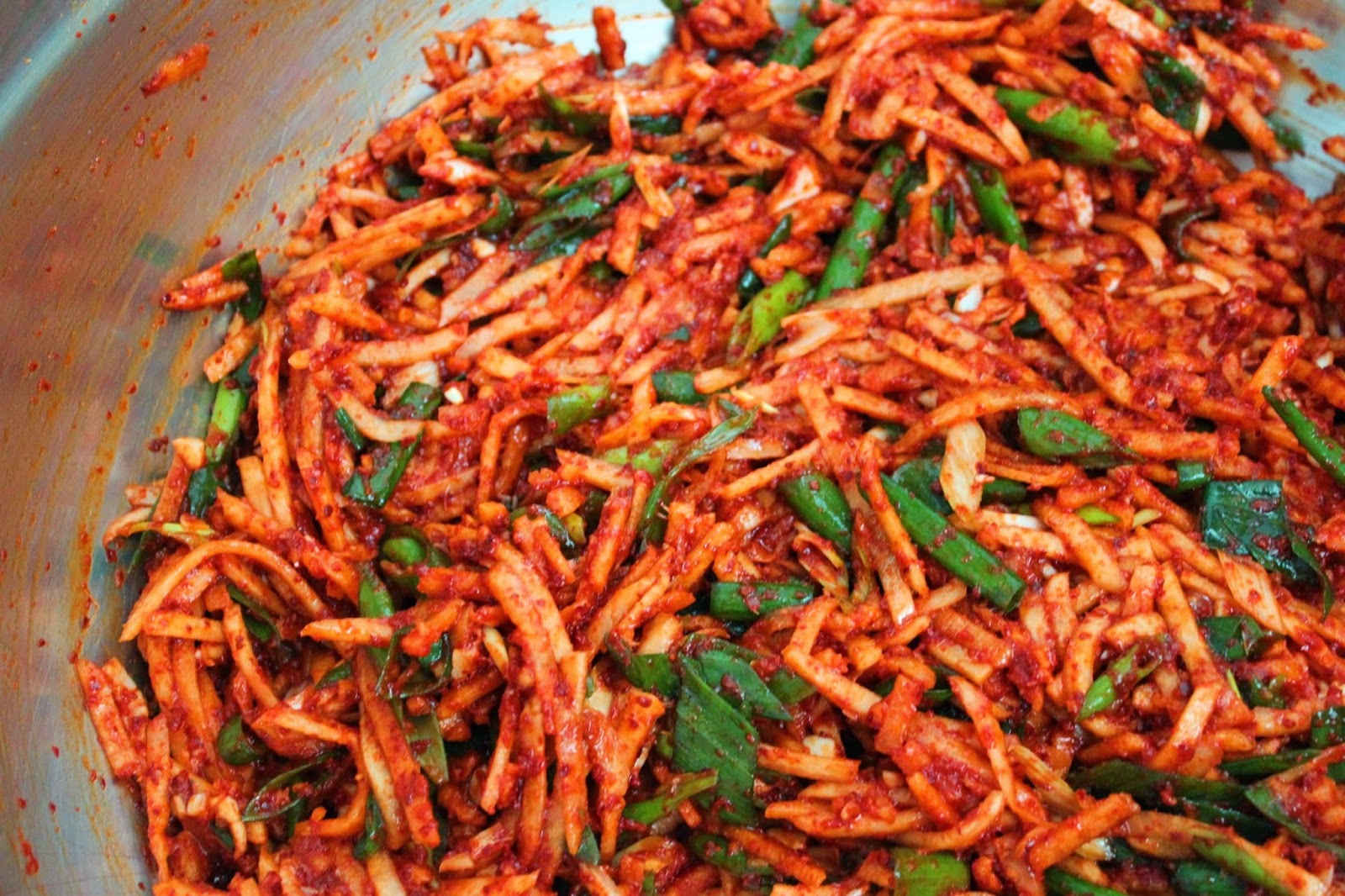
Kimchi (Korean: 김치) is a traditional fermented Korean side dish made of vegetables with a variety of seasonings. It is often described as spicy and sour.
Koreans eat so much of this super-spicy condiment (40 pounds of it per person each year) that natives say “kimchi” instead of “cheese” when getting their pictures taken. The reddish fermented cabbage (and sometimes radish) dish—made with a mix of garlic, salt, vinegar, chile peppers, and other spices—is served at every meal, either alone or mixed with rice or noodles.
Traditionally, the greatest varieties of kimchi were available during the winter. In preparation for the long winter months, many types of kimjang kimchi (hangul: 김장 김치) were prepared in early winter and stored in the ground in large kimchi pots. Today, many city residents use modern kimchi refrigerators offering precise temperature controls to store kimjang kimchi. November and December are traditionally when people begin to make kimchi; women often gather together in each other's homes to help with winter kimchi preparations
Ingredients and preparation
- 2 heads Napa cabbage, cut into quarters or 2-inch wedges, depending on size of cabbage
- 4 cups coarse salt
- 1 bulb garlic, cloves separated and peeled, and minced
- 1 Asian radish, peeled and shred into 5 cm long, 0.5 cm wide/thick.
- 1 (2-inch) piece of ginger root, peeled and minced.
- ¼ cup fish sauce and ¼ cup Korean salted shrimps
- 1 bunch of green onion
- 1 cup Korean chili powder
- 1 table spoon sugar (optional)
- 1 Asian pear, peeled and shred into 5 cm long, 0.5 cm wide/thick (optional)
Directions
- Trim the bottom and leaves of the napa cabbage, put a deep knife slit lengthwise and split it into two parts by hands. Marinate them in salt water in which half of the coarse salt dissolved, and spread remained half of the salt in between the petioles. Let it sit cutting side up for 3 hours after turn over
- Rinse the cabbage for 3~4 times, drain water on tray for about 1 hour. (You can get a salted napa cabbage at Korean market, if you pay a little more money.Today I bought a salted napa cabbage. )
- Add soaked Korean chili powder to shred radish, ¼ cup fish sauce, salted shrimps, and 1 table spoon sugar, shred pear, green onion, minced garlic, minced ginger, and mix well. And season with salt.
- Pack the seasonings in between each leaf of the cabbage, fold over the outer leaves to hold the seasonings.
- Place it in a jar.
- Keep it at room temperature for 1 day and it will ferment in a few days. And you should keep it in refrigerator.
Trim the bottom and leaves of the napa cabbage,
put a deep knife slit lengthwise and split it into two parts by hands.
Marinate them in salt water in which half of the coarse salt dissolved,
and spread remained half of the salt in between the petioles.
Let it sit cutting side up for 3 hours after turn over
Rinse the cabbage for 3~4 times, drain water on tray for about 1 hour.
You can get a salted napa cabbage at Korean market,
if you pay a little more money.
Today I bought a salted napa cabbage.


Add soaked Korean chili powder to shred radish, ¼ cup fish sauce,
salted shrimps, and 1 table spoon sugar, shred pear, green onion,
minced garlic, minced ginger, and mix well. And season with salt.
Pack the seasonings in between each leaf of the cabbage,
fold over the outer leaves to hold the seasonings.
Place it in a jar.
Keep it at room temperature for 1 day and it will ferment in a few days.
And you should keep it in refrigerator.
Reference:
wikipedia.org/wiki/Kimchi
http://www.health.com/ World's
Healthiest Foods: Kimchi (Korea)
The Beauty of Korean Food : with 100 Best Loved Recipes










0 comments:
댓글 쓰기